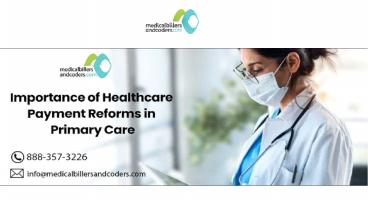Importance of healthcare payment reforms in Primary care - PowerPoint PPT Presentation
Title:
Importance of healthcare payment reforms in Primary care
Description:
According to the National Academies of Sciences, Engineering, and Medicine; high-quality primary care implementation needs urgent significant healthcare payment reform, telehealth capabilities, and team-based care. – PowerPoint PPT presentation
Number of Views:50
Title: Importance of healthcare payment reforms in Primary care
1
(No Transcript)
2
Importance of healthcare payment reforms in
Primary care
Primary care should always be a public priority
for any country. It serves people throughout
their lives, for everything from school-mandated
health checkups to managing multiple chronic
conditions, but it remains inaccessible to many
people. Moreover, Due to the covid-19 pandemic
primary care visits have declined significantly
and struggled with sufficient cash flow to keep
their practices afloat. According to the
National Academies of Sciences, Engineering, and
Medicine high-quality primary care
implementation needs urgent significant
healthcare payment reform, telehealth
capabilities, and team-based care. The report
focuses on various aspects such as declining
workforce and compensation for primary care. For
example- According to a report, 85 deaths per day
are associated with the declining workforce in
primary care and when compared with another
specialty Compensation in primary care is
typically lower. Lets try to understand primary
care spending and reforms in the following
brief The decline in primary care spending
3
Importance of healthcare payment reforms in
Primary care
According to the Primary Care Collaborative
(PCC), primary care spending across commercial
payers decreased to just 4.67 percent in 2019
from 4.88 percent of national healthcare spending
in 2017. Moreover, the COVID-19 pandemic
affected primary care practices to face declining
revenues, which has led to widespread reductions
in workforce and even practice closures. Unfortun
ately, the US is moving away from primary care,
despite the evidence that it is associated with
better value, including enhanced population
health, greater equity, and more efficient use of
healthcare resources. However, to improve
primary care investment, PCC advised states to
consider value-based payment models to enhance
their efforts to address health disparities in
the spotlight because of COVID-19. Now lets
understand some healthcare payment reforms in
Primary care The transition from a
fee-for-service payment model to hybrid models
4
Importance of healthcare payment reforms in
Primary care
The Healthcare of the US is progressing rapidly
with advancements in technology.
Community-oriented, coordinated, team-based care
is now possible with the help of new and improved
data sharing, consumer-facing healthcare apps,
telemedicine, and other capabilities. But
fee-for-service does not align with this version
of care delivery. FFS VS The value based
care Fee-for-service (FFS) is a very common
payment model wherein physicians and other
healthcare providers are paid separately for each
unbundled service. Hence providers emphasize the
quantity of care (office visits, procedures,
tests, treatments, etc.) rather than the quality
of care. While the value based care payment
model bills on patient satisfaction and positive
outcomes rather than individual services
rendered, which also makes the option for
bundling payments available. Incentives offered
through this model motivate healthcare providers
to work together to give longer-lasting, more
meaningful care and build closer relationships
with their patients. However, it is needed for
an hour that both public and private payers
should adopt hybrid models instead of
fee-for-service payment models to promote better
health outcomes and shift into value-based care
as the default payment model.
5
Importance of healthcare payment reforms in
Primary care
- CMS should revise and increase payment rates for
primary care physicians with the help of
identifying overpriced procedures and services to
cut costs would make this feasible. - As mentioned above NASEM offers insights for
primary care in its report which states that
high-quality primary care is a common good to
improve population health and reduce health
disparities. - Some recommendations from the National Academy of
Sciences, Engineering, and Medicine (NASEM)
report for primary care are given below - Payers should evaluate and disseminate payment
models based on their ability to promote the
delivery of high-quality primary care, not
short-term cost savings. - Payers using fee-for-service models for primary
care should shift toward hybrid reimbursement
models, making them the default over time. For
risk-bearing contracts, payers should ensure that
sufficient resources and incentives flow to
primary care. - CMS should increase the overall portion of health
care spending for primary care by improving the
Medicare fee schedule and restoring the Relative
Value Scale Update Committee (RUC) to its
advisory nature.
6
Importance of healthcare payment reforms in
Primary care
- States should facilitate multi-payer
collaboration and increase the portion of health
care spending for primary care. - Now you have a better understanding of various
metrics of primary healthcare and how to deal
with them, especially payment factors. If you are
still looking for any help for your primary care
practice, we are delighted to help you out!
You get in touch with us.































